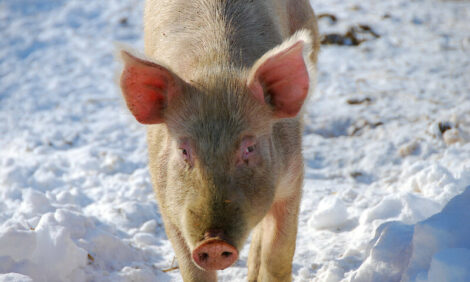



Hog producers not yet bashed by high feed cost
US - Hog prices have generally kept up with the high costs of production due to higher priced feed. In the first quarter of the year, live prices averaged $46.20 per hundred weight, slightly under costs of production.
Since the end of March, hog prices have seen a strong seasonal surge, actually putting some green in bank accounts of hog producers. Hog prices were about $42 in late March, but rallied as high as $54 in the past few weeks. Current costs of production are estimated to be in the $47 to $49 range for farrow-to-finish production.
Hog prices have tracked somewhat higher than anticipated due to moderate supply growth and continued positive news for pork trade. For the first four months of the year, U.S. packing plants turned out 2.5 percent more pork, and live hog prices were almost 10 percent higher. The conclusion that this represents a demand increase is premature as the higher hog prices actually resulted from trade issues and narrow marketing margins.
While U.S. packers were turning out more pork, this did not mean consumers had more pork in the meat case because of trade flows. Exports were up about three percent, but more importantly, pork imports were down about eight percent. The net impact was a 10 percent increase in “net” trade. As a result, the amount of pork in the domestic market was up modestly, but when adjusted for population growth in the U.S., the available pork per person was actually down. A smaller supply per person should mean higher pork prices.
The second factor stimulating hog prices was a narrow retail price margin. Generally speaking, when packer or retail margins are smaller the producer tends to get more of the consumer pork dollars. That has been the case so far this year. Consumers have paid $.03 per retail pound more for pork, and retail margins have been $.05 per retail pound less. This translates into higher hog prices for producers. In fact, prices so far this year have averaged $46.60 compared to $42.70 during the same period last year. That’s almost $4.00 more and a welcome outcome in this period of higher costs.
Can hog prices stay ahead of costs? That will depend not only on hog prices but also on weather conditions and feed prices. The answer right now is both yes and no! First, a look at hog prices. Prices look strong for the months of June, July, and August, when they are expected to average in the $52 to $53 range. However, by August prices may drop below $50 and may even drop into the mid-$40s for the last quarter of the year. Prices also tend to be relatively weak in the winter, with an anticipated average in the $45 to $49 range, and then tend to increase seasonally, with an anticipated average in the low $50s in the spring of 2008.
While this hog price outlook is for an average price near $50 for the next 12 months, given current corn and soybean meal futures prices, this will mean some periods of profits and some periods of losses. Expected profits are on tap for this summer when they could average about $4.00 to $5.00 per hundred and next spring when they may be about $2.00. However, there may be some periods of losses as well, especially around the seasonal low for hog prices in the fall and winter of 2008. Losses at that time are estimated to be from $1.00 to $3.00.
The financial view over the next 12 months for pork producers is for breakeven to $2.00 of profits per hundredweight. This means the industry overall cannot handle much higher corn and meal prices. Given current hog price forecasts and meal futures prices, the breakeven price for corn is estimated to be around $3.80 per bushel over the next 12 months. This means hog producers will be watching weather forecasts almost as closely as crop producers in the next few months.
Hog prices have tracked somewhat higher than anticipated due to moderate supply growth and continued positive news for pork trade. For the first four months of the year, U.S. packing plants turned out 2.5 percent more pork, and live hog prices were almost 10 percent higher. The conclusion that this represents a demand increase is premature as the higher hog prices actually resulted from trade issues and narrow marketing margins.
While U.S. packers were turning out more pork, this did not mean consumers had more pork in the meat case because of trade flows. Exports were up about three percent, but more importantly, pork imports were down about eight percent. The net impact was a 10 percent increase in “net” trade. As a result, the amount of pork in the domestic market was up modestly, but when adjusted for population growth in the U.S., the available pork per person was actually down. A smaller supply per person should mean higher pork prices.
The second factor stimulating hog prices was a narrow retail price margin. Generally speaking, when packer or retail margins are smaller the producer tends to get more of the consumer pork dollars. That has been the case so far this year. Consumers have paid $.03 per retail pound more for pork, and retail margins have been $.05 per retail pound less. This translates into higher hog prices for producers. In fact, prices so far this year have averaged $46.60 compared to $42.70 during the same period last year. That’s almost $4.00 more and a welcome outcome in this period of higher costs.
Can hog prices stay ahead of costs? That will depend not only on hog prices but also on weather conditions and feed prices. The answer right now is both yes and no! First, a look at hog prices. Prices look strong for the months of June, July, and August, when they are expected to average in the $52 to $53 range. However, by August prices may drop below $50 and may even drop into the mid-$40s for the last quarter of the year. Prices also tend to be relatively weak in the winter, with an anticipated average in the $45 to $49 range, and then tend to increase seasonally, with an anticipated average in the low $50s in the spring of 2008.
While this hog price outlook is for an average price near $50 for the next 12 months, given current corn and soybean meal futures prices, this will mean some periods of profits and some periods of losses. Expected profits are on tap for this summer when they could average about $4.00 to $5.00 per hundred and next spring when they may be about $2.00. However, there may be some periods of losses as well, especially around the seasonal low for hog prices in the fall and winter of 2008. Losses at that time are estimated to be from $1.00 to $3.00.
The financial view over the next 12 months for pork producers is for breakeven to $2.00 of profits per hundredweight. This means the industry overall cannot handle much higher corn and meal prices. Given current hog price forecasts and meal futures prices, the breakeven price for corn is estimated to be around $3.80 per bushel over the next 12 months. This means hog producers will be watching weather forecasts almost as closely as crop producers in the next few months.








